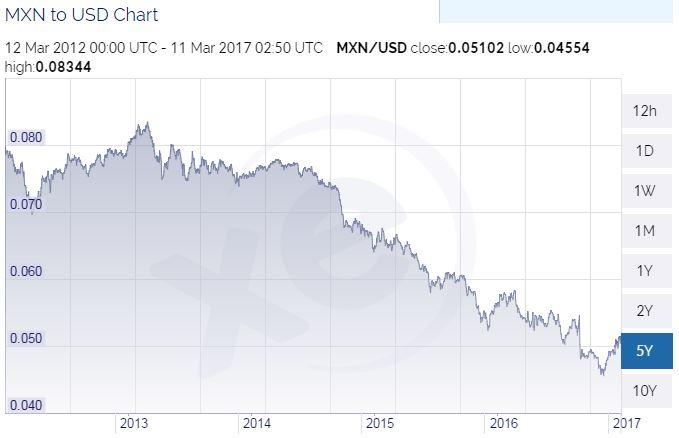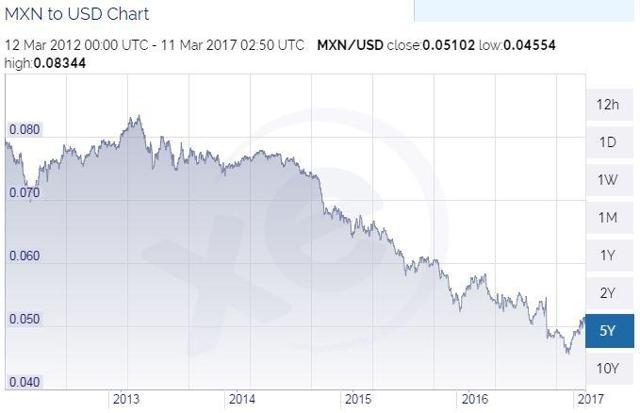
I strongly believe value investing works and that it works in all market conditions. That being said, the crux of value investing is buying something for less than its worth, the proverbial “fifty cent dollar.” Generally speaking, most people will not choose to sell their property to anyone, including anonymous strangers through the stock exchange, for half of its true value. Thus, value investors looking for a bargain do better to look in areas where there is some reason for the market to have missed the value inherent in a security. The best places, however, are where the existing owners have some reason to think that what they own isn’t valuable and are willing to sell for non-fundamental reasons.
Volatility of various kinds is the usual backdrop for the best deals in the market. While most of the volatility in the US markets lately has been of the “up” variety, that isn’t true in all sectors and all geographies.
Mexico
One place that has had the type of volatility that is likely to produce bargains lately is Mexico. The rhetoric from President Trump on the campaign trail and after his election has weighed on the country’s stock market, and more especially on its currency. The uncertainty associated with the country’s largest neighbor and the biggest economy in the world having an uncertain trade policy towards Mexico have created volatility in its markets, and volatility creates opportunity.
Interestingly, the largest effect of the volatility has been a devaluation of the Mexican peso. Immediately after the election, the peso was down over 20% on the year, although it has recovered somewhat since then as there hasn’t been much progress on the more dramatic campaign promises (no big wall yet). You can see, however, that the peso has still depreciated dramatically over the past few years.
Source: XE.com
That has naturally created winners and losers. Additionally, it has created an opportunity for the market to misjudge which companies are winners and which are losers. That has major implications for investors from other countries, as they can buy Mexican assets more cheaply in US dollar terms, even if they haven’t depreciated in Mexican peso terms.
Why not just buy an ETF?
Those who have read my writing before will know that I would never write a macro article without at least a few ideas on investments to buy. A fair question for an article with a thesis that Mexican stocks may be undervalued is why not just buy an ETF? There are a number of options, including iShares MSCI Mexico Capped ETF (EWW) and ProShares Ultra MSCI Mexico Capped IMI ETF (UMX). An ETF provides a diversified exposure to the country, is traded on a US exchange, and has low costs.
Another diversified option is a closed end fund such as the Mexico Fund (MXF). It trades at a nearly 12% discount to the NAV of the fund, which is a bigger discount than its five-year average. The other side of that coin is that the expense ratio is much higher than the ETF choices.
The downside to the diversified options is that they provide exposure to companies that will be hurt by the devaluation. For example, EWW has a large position in Banorte (OTCQX:GBOOF), a major bank. Bank loans are uniquely vulnerable to a currency devaluation, as they are denominated in local currency. They also have a large position in Wal-Mart De Mexico (OTCQX:WMMVY). Selling imported goods is a naturally poor position to be in during a currency devaluation. Now, Wal-Mart may take market share in an inflationary environment with its low prices philosophy, so I mention these more to suggest that a currency devaluation will cause winners and losers, and an ETF will own both.
What to buy in a Currency Devaluation
The key thing to do in a currency devaluation scenario is buy assets that won’t depreciate with the currency. That means anything where the assets are not truly denominated in currency.
To explain by way of a counter-example, a Mexican bond is 100% denominated in Mexican pesos. In exchange for money now, the issuer promises to give you a fixed amount of pesos sometime in the future. If the peso has depreciated, that fixed amount of pesos will be worth less to you in other currency, but the issuer will not top up the payments. Any regulated business where the asset base provides a fixed return denominated in pesos (eg., utilities) would have a similar issue.
The direct opposite is buying hard assets that aren’t truly denominated in that currency. An example would be a Mexican national taking their peso-denominated savings and buying gold. While they would be exchanging pesos for gold, the value of that gold would not be expected to fluctuate with the value of a peso. That is why you will often see a flight to gold during hyper-inflation, as it holds its value and is portable.
Of course, gold isn’t a productive asset and most investors reading this probably aren’t buying using pesos. But there are a number of characteristics of a business operating in a currency devaluation that may be attractive.
Real commodity assets are of course the obvious ones. If a company produces oil, timber, or gold, their sales are likely to be denominated in hard currency, while their costs are often in local currency. The biggest commodity industry in Mexico by far is oil production, but it is run by a state-owned company, which reduces the opportunity for investors to participate.
There are two other types of businesses that I believe to be attractive in a currency devaluation. The first is exporters. If a company produces its product with the majority of its costs in Mexico, but sells it abroad in hard currency, a devaluation will have a potentially salutary effect on its profit margins. Mexico has some major exporters, but many of them are now subsidiaries of foreign companies. The biggest example of that is Grupo Modelo, seller of Corona (everywhere except the USA), which was purchased by Anheuser-Busch InBev (BUD) in 2013. That provides a potential boost to BUD margins, but given the scale of that enterprise it isn’t likely to move the needle.
The final type of business that may benefit from a currency devaluation is one that operates domestically but has pricing power. That could be from the ability to pass on rising prices to its customers, or because the value of its assets is directly tied to real assets.
The most logical type of businesses with those characteristics are real estate businesses with short leases and branded products businesses that produce domestically. Branded products businesses often have pricing power, especially when the perceived ratio of value to price is high. One example of a branded products business that should have pricing power in a devaluation is Kimberly-Clark de Mexico (OTCPK:KCDMY). There is a great article on the company by Ian Bezek here, which covers the company extensively.
Lodging Businesses
All that being said, I believe the best type of business to buy in a currency devaluation is a hotel. A hotel is a real tangible and physical asset, which means it is not truly denominated in local currency. As with other real estate, it will tend to have an intrinsic value which is independent of currency fluctuations. Unlike other real estate assets, however, hotels have very short leases. While class A office space can be leased for a very long time (up to 30 years) a hotel guest tends to stay for a few days or weeks at most. Thus, a fixed term lease attached to a building denominated in a depreciated currency can end up being a big liability, whereas a hotel has the ability to reprice its inventory quickly.
Also, because they own real estate assets, hotel operators have the ability to take on debt. This is a key factor in a currency devaluation, because a company with debt denominated in local currency can pay back its liabilities with less value than it received when it took them on. A debtor is in exactly the opposite position of a bondholder, as they will pay back the same amount of pesos as they borrowed, but the assets they bought with the money will have appreciated.
The final reason I think lodging companies will benefit from the currency devaluation is the propensity to travel. Foreign travelers are more likely to travel to Mexico when the currency is low. The flip side of that is that domestic travelers are more likely to stay inside the country, as their currency provides less value internationally. So aside from the repricing of the room inventory to current price levels, lodging operators can also expect improved volume. This is a larger factor for leisure operators than business hotels, but should affect all operations at least slightly.
Conclusion and Ideas
I have tried to write this piece in a way that it would be a valuable reference for future currency devaluations in other countries, or for investors who think a certain currency is overvalued to determine how that will affect their portfolio holdings. That being said, I wanted to include some ideas that I believe are actionable now. The first is Pace Holdings (PACE) which is a cash shell [SPAC] in the process of merging with a Mexican all-inclusive resort operator Playa (PLYA). I wrote an extensive report on the company and its prospects here. I have also written up a Mexican hotel operator with a >8% yield on my subscription service, the Microcap Review. I am long multiple companies in the space as a way of expressing this view.
Editor’s Note: This article discusses one or more securities that do not trade on a major U.S. exchange. Please be aware of the risks associated with these stocks.



